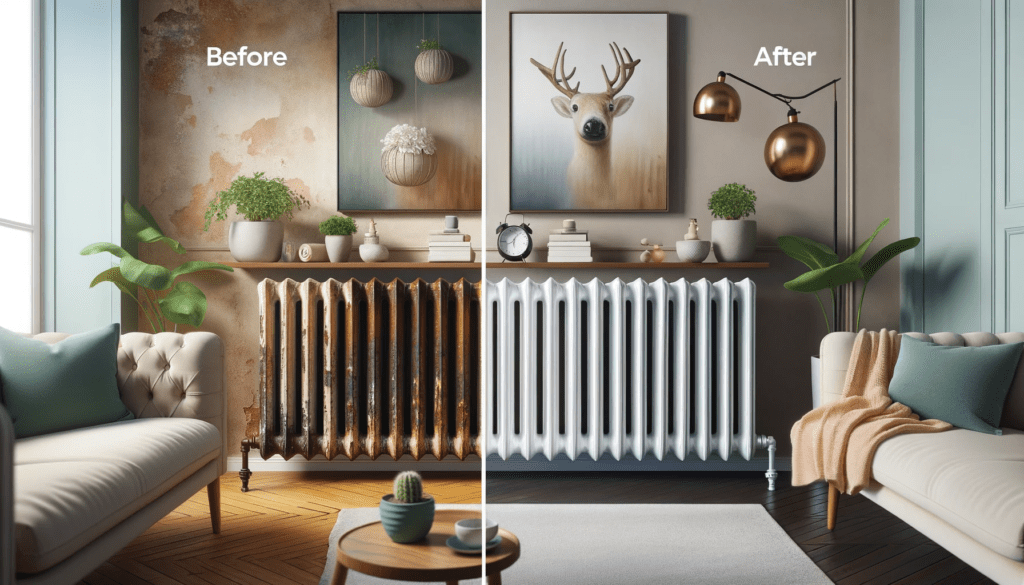Imagine walking into a room and being greeted by a stylish, freshly painted radiator that blends perfectly with your interior decor. This isn’t just a dream, it’s a simple, yet transformative DIY project you can undertake to elevate the look and feel of your home. In this guide abut how to repaint a radiator, we will delve into the art of radiator repainting, offering you professional, actionable advice that will not only enhance the aesthetic appeal of your space but also improve the efficiency and longevity of your radiators.
Why Repaint Your Radiator?
Repainting your radiator does more than just update its look. It’s an investment in your home’s efficiency and style. Radiators, over time, can show signs of wear # chipping paint, rust, and discoloration. A fresh coat of paint can protect against these elements, ensuring your radiator operates at peak efficiency.
Preparing Your Radiator for Painting
Proper preparation is crucial. Here’s how to do it:
- Turn Off the Radiator: Ensure it’s completely cool before starting.
- Clean the Surface: Remove dust and rust. Use fine-grit sandpaper for a smooth base.
- Protect Surrounding Areas: Use drop cloths and painter’s tape to protect walls and floors.
The Painting Process
- Apply Primer: Use a heat-resistant primer for better paint adhesion.
- Painting Techniques: Use a brush or roller for a traditional approach, or opt for spray paint for a more uniform finish.
- Layering: Apply multiple thin layers, allowing adequate drying time between coats.

The Right Paint Makes All the Difference
The secret to a successful radiator repaint lies in choosing the right paint:
- Heat-Resistant Paints: These are specifically formulated to withstand the high temperatures of a radiator, preventing cracking and discoloration.
- Rust-Inhibiting Primers: A good primer will help prevent rust and ensure your paint adheres properly.
Selecting the right paint for your radiator is crucial for achieving a durable and high-quality finish. In the UK, there are several reputable brands known for their excellent radiator paints. Here are the top three choices:
- Rust-Oleum Radiator Enamel Paint: Rust-Oleum is a well-known brand that offers a specialized enamel paint for radiators. Their formula is designed to withstand high temperatures, prevent rust, and maintain colour without yellowing over time. It’s available in various colours, providing a glossy, heat-resistant finish that is both durable and easy to clean.
- Hammerite Radiator Paint: Hammerite is renowned for its durable and protective paints. Their radiator paint is specifically formulated for the heat and demands of a radiator surface. It’s a tough, long-lasting paint that resists yellowing and provides a smooth, satin finish. Hammerite paints are also known for their quick drying properties, making them a convenient choice for busy homeowners.
- Dulux Quick Dry Satinwood Paint: While not exclusively a radiator paint, Dulux Quick Dry Satinwood is a versatile option that works well on radiators due to its heat-resistant properties. It’s a water-based paint, which means it’s low odor and quick-drying, with a hard-wearing finish that resists yellowing. This paint is particularly popular for its ease of application and availability in a wide range of colours.
When choosing paint for your radiator, it’s important to consider factors like heat resistance, durability, finish (gloss, satin, matte), drying time, and colour options. Additionally, always ensure the area is well-ventilated during painting and follow all safety instructions provided by the paint manufacturer.



How to Repaint Behind the Radiator
Repainting behind a radiator can seem like a daunting task due to the limited space and difficult access. However, with the right tools and techniques, you can achieve a seamless and professional finish. Here’s how to tackle this challenging area:
Tools You’ll Need
- Radiator Roller: A long-handled, slim roller specifically designed for painting behind radiators.
- Paintbrush: A long, angled brush can help in tight corners.
- Radiator Paint: Ensure you use heat-resistant paint suitable for radiators.
Step-by-Step Guide
Safety First: Make sure the radiator is turned off and completely cool. It’s best to do this task during warmer months when the radiator is not in use.
Prepare the Area: Lay down drop cloths to protect your floors and use painter’s tape to cover any areas you don’t want to paint.
Accessing Behind the Radiator: If possible, slightly loosen the radiator brackets and gently pull the radiator away from the wall for better access. If you cannot move the radiator, don’t worry – the tools mentioned will help you reach behind it.
Paint Application:
- Using a Radiator Roller: Dip the roller in paint, ensuring it’s not overloaded. Gently slide the roller behind the radiator, moving it vertically for even coverage.
- Using a Paintbrush: For corners and edges, use the angled brush. Be careful to apply thin, even coats to avoid drips.
Drying Time: Allow adequate drying time between coats, as recommended by the paint manufacturer. This step is crucial, especially in confined spaces with limited airflow.
Final Checks and Touch-Ups: Once the paint is dry, check for any missed spots or uneven areas. Apply touch-ups as needed.
Tips for a Professional Finish
- Patience is Key: Work slowly and methodically to ensure even coverage.
- Lighting: Use a flashlight or work light to better see the area you are painting.
- Ventilation: Ensure good ventilation in the room to aid drying and reduce paint fumes.

Wen to Consider Professional Help
If you’re unsure about the type of primer to use, or if the radiator has extensive rust or damage, it might be wise to consult a professional. Professional painters have the expertise to select the right products and apply them correctly, ensuring a long-lasting and high-quality finish. Properly priming a bare metal radiator is crucial for achieving a high-quality, durable finish. By following these steps and using the right materials, you can ensure that your radiator not only looks great but also stands the test of time. Remember, for best results, consider hiring professional services like ours at Painters and Decorators London to handle your radiator painting needs.
Contact Us for Professional Radiator Repainting
At Painters and Decorators London, we understand the importance of a well executed radiator repaint. Our team of experts is equipped with the right tools and knowledge to bring your vision to life. For a hassle-free, high-quality radiator repainting service, don’t hesitate to contact us. Your satisfaction is our priority! Repainting your radiator is more than just a maintenance task; it’s an opportunity to enhance the beauty and efficiency of your home. By choosing the right paint, preparing thoroughly, and considering professional services, you can achieve a stunning and durable finish. Transform your space today and enjoy the warmth and style of your newly painted radiator!



